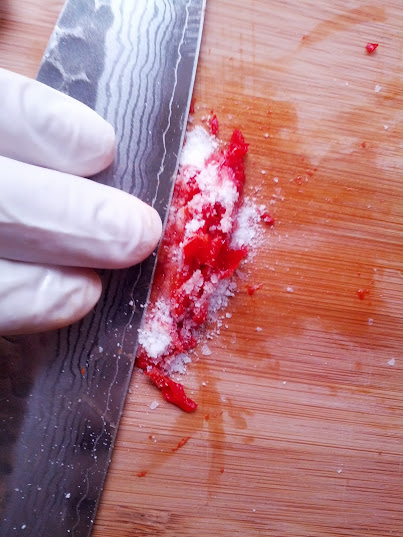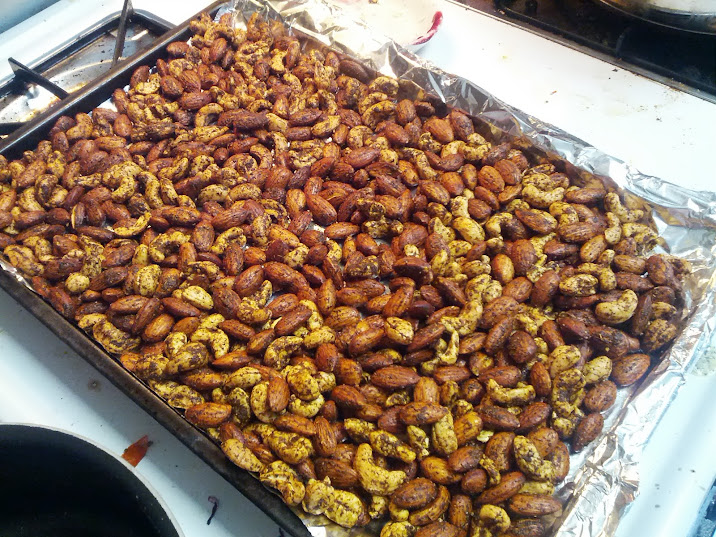 |
| Product of Canada? Really? |
Mango and I stopped by Buford Farmer's Market one day to pick up some groceries for the week. As we walked through the produce section my gaze fell upon the little plastic container above. Mango and I both gave each other a look, I shrugged, and I threw it into the basket. Common sense would not prevail this day.
 |
| Cute huh? |
 |
| I had to try a bit of one just to see what I was dealing with. Yep. They're spicy alright. |
A Word on Chile Pepper Safety
Needless to say, you need to be careful with these things, or any of the really hot chile peppers. I highly suggest working with rubber gloves when dealing with extremely hot chiles. Even for something like serranos, which are "only" 10,000 - 25,000 on the Scoville scale, you really ought to use gloves. This is not a matter of being a whimp - it's a matter of not getting capsaicin on your hands and then transferring it to your eyes* later on.
*Or, y'know... "down there". Which I did once when I forgot to wash my hands before using the little panda's room. Lesson learned.
Make sure you keep things very clean. Wash everything off after you use it, and try to avoid touching things with your bare skin before you wash them. I'd also suggest using a cutting board on top of your regular one that you don't mind getting chile juices on (this keeps you from getting capsaicin on your cutting board, which in turn can get on other foods you'll chop on it). Also make sure you do this in a well ventilated room, as the fumes that are produced from extremely hot chiles can sometimes sting your nose/eyes a little; open a window if you can.
If the idea of using chile peppers that can be weaponized kind of freaks you out, or you're just not
In short - just use common sense and be careful.
On to the Nuts
 |
| Not too many seeds in this one |
When putting a "wet" ingredient like a chile pepper into a dish like this, you want to make sure you get an even distribution, otherwise someone will eat a big chunk of pepper and blow their head off. The best way I've found is to turn the ingredients into a paste, and then cook that paste in the oil you're going to coat the nuts with.
Simply mince your chile up on your cutting board, sprinkle on a good pinch of kosher salt, then use the flat side of your knife to grind the chile against your board. This will turn it into a paste. The same thing can be used with garlic (and garlic would be a mighty fine addition if you wanted to throw some of that in, too).
Put your oil(s) in a pan over medium heat and toss in your crushed chile. Stir it up a bit and let it cook. Keep your face pointed away from it if the fumes bothers you. You're done when it stops foaming.
Pour the infused oil over your mixed nuts and toss to coat evenly. I used cashews and almonds, but most any nut will do. Just be sure to use raw (unroasted) nuts because we're going to be roasting these in the oven.
Put together your spice blend (recipe below) and buzz it up in your spice grinder or grind it up with your mortar and pestal. Then sprinkle this over your nuts and toss to combine.
NOTE: It is actually pretty important to pulverize everything, especially the salt. If the salt or anything else is too "chunky" (the grains are too big) it won't stick to the nuts. It has to be pretty fine.
How much of the spice mixture you use entirely depends on how much you want. Sprinkle on about a quarter of your mixture, taste a nut, then adjust from there. Then just pop them in the oven and cook until fragrant!
The end product is actually not that spicy. Spicy for sure, but not spicy enough to incapacitate you. I brought them with me to a July 4th party and, while everyone did acknowledge that they were pretty spicy, they appeared to be a big hit.
I hope you enjoy putting my nuts in your mouth*.
* I had to work one of those jokes in somewhere. I know, I'm 12.
Trinidad Scorpion Mixed Nuts
2lb unsalted mixed raw nuts (almond, cashews, walnuts, etc)
1/2tbsp coconut oil or butter
1/2tbsp olive oil
1 fresh Trinidad Scorpion pepper, or any other combination of chile peppers your like
Spice blend (to taste):
- 1 part whole pepper corns
- 1 part herbs de provence, rosemary, or any other dried herb you like
- 1 part chili powder
- 1 part kosher salt
Preheat oven to 300F. Put mixed nuts in a large bowl and set aside. Line a sheet pan with aluminum foil.
Mince the chile pepper, then crush using kosher salt and the flat side of your knife until you've made a paste. Add the oils to a small pot and place over medium low heat. Add the chile paste to the oil and stir to combine. Cook until the mixture no longer foams. Pour the chile infused oil over the mixed nuts and stir to combine. Add the spice blend incredients to a spice grinder and grind until fine. Sprinkle spice mixture over the nuts, stirring to combine and tasting until you're happy with how they taste.
Pour the nuts onto the sheet pan, spread out evenly, then roast in the oven until fragrant, about 10-15 minutes. Remove from the oven and a allow the nuts to cool thoroughly before putting them in a container.
Panda: Trinidad Scorpion pepper mixed nuts are in the oven. Please say a prayer for my gastrointestinal tract.
Mango: *bringing home gas masks and gloves from work*





















































